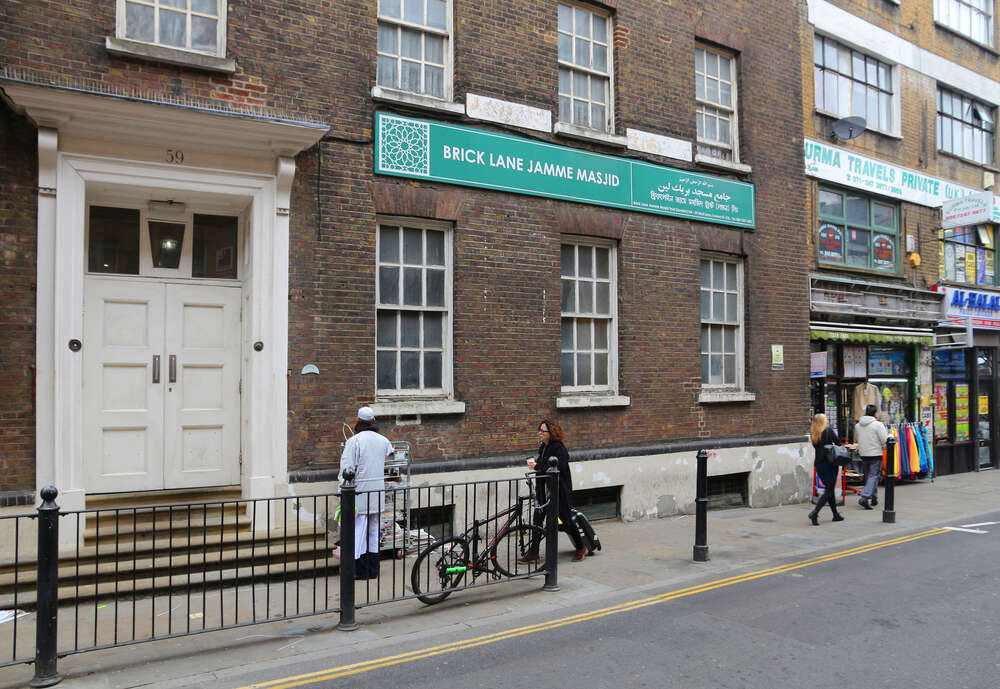
There’s a mosque a short walk from Whitechapel station on Brick Lane, one of the many that serve the large Bengali population who live in the East End. Originally called the London Great Mosque (“Jamme Masjid” in Bengali), it is now known only as the Brick Lane Mosque, following the building of much larger Islamic centres around London, such as one nearby on Whitechapel Road.

High above the separate entrances for men and women on a stone sundial are carved the Latin words Umbra Sumus. These words and the date above them betray the long history of the building that has stood unassumingly on the corner of Fournier Street and Brick Lane for some 280 years. A building housing the religions of the successive waves of immigrants, Protestant, Jewish and Muslim, who have defined the East End and London itself for hundreds of years.
The building was originally built in 1743 as a church by the French Huguenots who settled in London after fleeing religious persecution in France. The revocation of the Edict of Nantes, by the French King Louis XIV in 1685, saw the rolling back of hard-won civil rights for Protestant religious minorities and their subsequent emigration from France. Those that came to London settled in the Brick Lane area and a thriving weaving industry developed. When this declined due to industrialisation in the north of England, the Huguenots moved West, contributing to the large French population in Kensington and Chelsea, Westminster, Hammersmith and Fulham. So their church on Brick Lane fell out of use.
The poverty of the area, as well as its proximity to the London docklands, meant that it remained the starting point for the historic stream of immigrants to the city. Following the Huguenots, Ashkenazi Jews fleeing the pogroms of Eastern Europe and Russia settled in the area during the 19th century.
Brick Lane Mosque through the years
Earlier the building on the corner of Fournier Street had briefly been used as a mission for the evangelical Society for Propagating Christianity among the Jews, an indigenous attempt to convert the immigrant community to the native religion. This was a short-lived and unsuccessful endeavour and the building soon became the main point of worship for the Jewish community, the “Great Synagogue”. Just as the Huguenots left before them, the new residents of Brick Lane and its surrounding area eventually moved out of the East End towards the leafy suburbs of North London.
Only four of the 150 synagogues that were built in Tower Hamlets remain today and the Great Synagogue on Brick Lane was one of those lost to history. The building was repurposed as a mosque for the Bengalis who inherited this part of London from the Jewish community. The current residents of Brick Lane mostly immigrated from Bangladesh after the country gained its independence from British colonial rule in 1947. Seeking work or fleeing the terrible war for secession from West Pakistan, which saw the creation of the modern state of Bangladesh, the ethnically Bengali community in Tower Hamlets grew rapidly in the second half of the 20th Century and now make up 32% of the borough’s total population.
Immigrants from across the world have thrived in the East End in spite of intense poverty and racism from those who came before. It was Jewish immigrants who stood against Oswald Mosley and his British Union of Fascists on Cable Street. Next door to the nearby East London Mosque on Whitechapel Road you can find Altab Ali Park, named after a young Bengali man who was murdered in a racially motivated attack during racial tension in the East End.
The pain and success of those who have lived in the East End is written on the streets of London, in the architecture, monuments, shops and lasting communities now scattered across the city. Each wave of immigrants leaves a shadow of themselves on the city long after they have gone and their children have become Londoners. Umbra Sumus means “We are shadows”; prophetic words carved in a long-dead language, by people who themselves died long ago.
[Read more: Why London’s first Ramadan lights celebration has been so important for Muslims everywhere]






